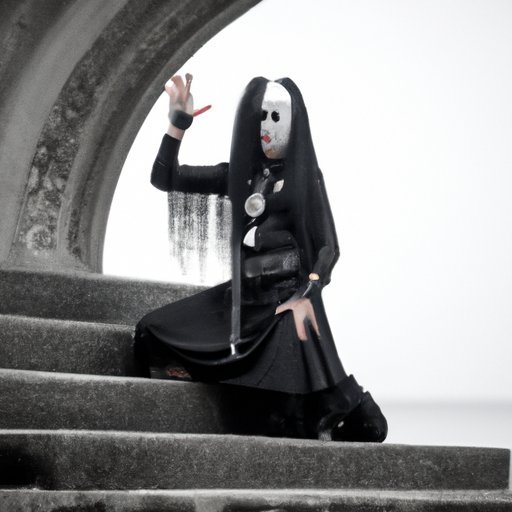Introduction
Goth culture is a unique subculture that has been captivating audiences for decades. From dark music and fashion to iconic architecture and artwork, goth culture encompasses a wide range of interests and activities. But what exactly is goth culture? And how did it come to be? In this article, we will explore the history, music, fashion, and more of this fascinating subculture.
History of Goth Culture
The origins of goth culture date back to the early 1980s in the United Kingdom. This period saw the rise of post-punk bands like Bauhaus, Siouxsie and the Banshees, and The Cure, whose sound was characterized by moody lyrics and minor keys. These bands would go on to become some of the most influential acts in the history of goth culture.
In addition to the music, goth culture was also influenced by literature, film, and fashion. Gothic novels such as Bram Stoker’s Dracula and Mary Shelley’s Frankenstein were popular during this time, and horror films like The Hunger and Blade Runner provided inspiration for goth fashion. By the mid-1980s, goth culture had established itself as a distinct subculture with its own sets of values, aesthetics, and lifestyle.
Sub-Genres of Goth Music
The music of goth culture is one of its defining characteristics. Over the years, a number of distinct sub-genres have emerged, each with its own style and sound. Here are some of the most popular sub-genres of goth music:
Darkwave
Darkwave is a sub-genre of goth music that combines elements of post-punk and new wave. It is characterized by dreamy synths, melancholic lyrics, and driving beats. Popular artists in this genre include Clan of Xymox, Faith and the Muse, and Switchblade Symphony.
Industrial
Industrial music is another popular sub-genre of goth music. It is characterized by distorted guitars, harsh vocals, and aggressive rhythms. Artists like Ministry, Skinny Puppy, and Marilyn Manson are some of the most influential acts in this genre.
Post-Punk
Post-punk is a genre of music that emerged in the late 1970s. It is characterized by angular guitar riffs, minimalistic drums, and dark, brooding lyrics. Some of the most influential post-punk bands include Joy Division, Siouxsie and the Banshees, and Bauhaus.
Deathrock
Deathrock is a sub-genre of punk rock that combines elements of punk, goth, and horror. It is characterized by heavy guitars, synthesizers, and morbid lyrics. Popular deathrock bands include Christian Death, Kommunity FK, and 45 Grave.
Goth Fashion & Style
Goth fashion is another key component of goth culture. While there is no single “goth look”, some of the most popular styles include:
Gothic Lolita
Gothic Lolita is a fashion style that combines elements of gothic and Victorian styles. It is characterized by frilly dresses, lace, and dark colors. Popular brands in this style include Baby, The Stars Shine Bright, and Alice Auaa.
Visual Kei
Visual Kei is a Japanese fashion style that is heavily influenced by gothic and punk styles. It is characterized by dramatic make-up, colorful clothing, and intricate hairstyles. Popular visual kei bands include X Japan, Dir En Grey, and Malice Mizer.
Cyber Goth
Cyber Goth is a style of goth fashion that combines elements of cyberpunk and rave culture. It is characterized by neon colors, metallic fabrics, and futuristic designs. Popular brands in this style include Cyberdog, Tripp NYC, and Demonia.
Steampunk
Steampunk is a style of fashion that combines elements of Victorian and industrial styles. It is characterized by corsets, top hats, and other Victorian-era garments. Popular brands in this style include Clockwork Couture, Steampunk Couture, and Alchemy Gothic.
Gothic Architecture & Visual Art
Gothic architecture and visual art are two of the most distinctive aspects of goth culture. Gothic cathedrals, with their pointed arches and ornate decoration, are a testament to the beauty and complexity of this style of architecture. Gothic paintings, such as those of Henry Fuseli, depict eerie and mysterious scenes. And gothic literature, such as that of Edgar Allan Poe, explore themes of death, madness, and the macabre.
Celebrating Goth Culture Festivals
Goth culture has inspired a number of festivals around the world. The Whitby Gothic Weekend in England is one of the longest-running events of its kind, featuring performances from gothic bands, workshops, and vendors. Wave-Gotik-Treffen in Germany is another popular event, drawing thousands of fans every year. And DarkMofo in Australia is a festival that celebrates the darker side of life through art, music, and more.
Goth Lifestyle & Community
Goth culture is not just about the music, fashion, and art – it is also about the community. There are dozens of online communities dedicated to goth culture, where fans can connect and discuss topics ranging from music to philosophy. There are also goth clubs and events where people can dress up, listen to music, and celebrate their love for the subculture. Finally, there are festivals and gatherings throughout the year where people can embrace the goth lifestyle.
Conclusion
Goth culture is a unique and vibrant subculture with a diverse array of interests and activities. From its origins in post-punk music to its influence on fashion and visual art, goth culture has something for everyone. Whether you’re into dark music, fashion, or art, there is a way for you to express yourself and find your place within this fascinating subculture.
(Note: Is this article not meeting your expectations? Do you have knowledge or insights to share? Unlock new opportunities and expand your reach by joining our authors team. Click Registration to join us and share your expertise with our readers.)
